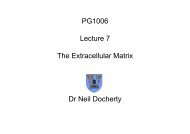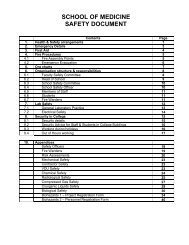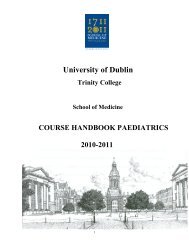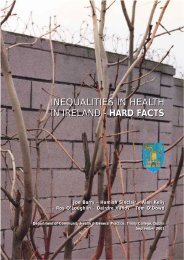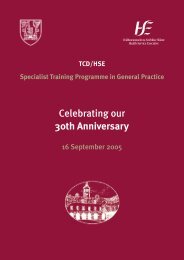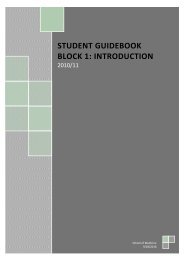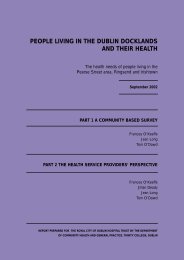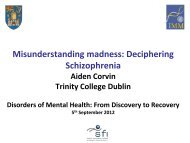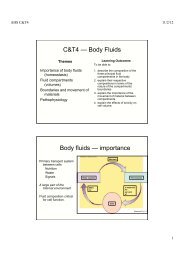people living in finglas and their health - School of Medicine - Trinity ...
people living in finglas and their health - School of Medicine - Trinity ...
people living in finglas and their health - School of Medicine - Trinity ...
You also want an ePaper? Increase the reach of your titles
YUMPU automatically turns print PDFs into web optimized ePapers that Google loves.
METHODS - PART 2 METHODS - PART 2<br />
Methods<br />
1.0 INTRODUCTION<br />
In November 2001, the Northern Area Health Board commissioned a study to <strong>in</strong>vestigate the <strong>health</strong> needs <strong>of</strong><br />
the <strong>people</strong> <strong>liv<strong>in</strong>g</strong> <strong>in</strong> the F<strong>in</strong>glas area. The Department <strong>of</strong> Community Health <strong>and</strong> General Practice, based at the<br />
Tr<strong>in</strong>ity College Centre for Health Sciences, Adelaide <strong>and</strong> Meath Hospital, Dubl<strong>in</strong>, <strong>in</strong>corporat<strong>in</strong>g The National<br />
Children’s Hospital, was requested to undertake the study.<br />
The first part <strong>of</strong> the study consisted <strong>of</strong> a household survey <strong>in</strong> the community <strong>and</strong> the results are presented <strong>in</strong><br />
Part 1 <strong>of</strong> this report. Dur<strong>in</strong>g January <strong>and</strong> February 2002, the service providers were contacted <strong>and</strong> <strong>in</strong>formed <strong>of</strong><br />
the household survey. They were also <strong>in</strong>vited to participate <strong>in</strong> a study to ascerta<strong>in</strong> the needs from the service<br />
providers’ perspective. Representatives from the different discipl<strong>in</strong>es with<strong>in</strong> the <strong>health</strong> services were <strong>in</strong>terviewed<br />
prior to commencement <strong>of</strong> the household survey.<br />
1.1 AIM<br />
The study set out to ga<strong>in</strong> an underst<strong>and</strong><strong>in</strong>g <strong>of</strong> the <strong>health</strong> needs <strong>and</strong> the current service provision <strong>in</strong> the area from<br />
the <strong>health</strong> service providers’ perspective. The research also sought to explore the participants’ perceptions <strong>of</strong><br />
co-ord<strong>in</strong>ation <strong>and</strong> teamwork amongst service providers <strong>and</strong> sought suggestions on how to facilitate the primary<br />
care team to work together effectively.<br />
1.2 RESEARCH DESIGN<br />
Given the importance <strong>of</strong> explor<strong>in</strong>g the service providers’ underst<strong>and</strong><strong>in</strong>g <strong>and</strong> experiences from <strong>their</strong> own<br />
perspectives this study employed a qualitative methodology, us<strong>in</strong>g a grounded theory approach.<br />
Grounded theory is a method <strong>of</strong> collect<strong>in</strong>g <strong>and</strong> analys<strong>in</strong>g qualitative data with the aim <strong>of</strong> develop<strong>in</strong>g theories that<br />
are grounded <strong>in</strong> real world observations. The goal <strong>of</strong> grounded theory is to provide a description or an<br />
explanation <strong>of</strong> events as they occur <strong>in</strong> reality, <strong>and</strong> not just as they have been perceived anecdotally.<br />
The <strong>in</strong>formation was collected through a semi-structured <strong>in</strong>-depth taped <strong>in</strong>terview. The semi-structured <strong>in</strong>terview is<br />
used when the researcher knows the type <strong>of</strong> questions to be asked but cannot predict the answers. This approach<br />
was chosen as it ensures the researcher obta<strong>in</strong>s the <strong>in</strong>formation required while at the same time permitt<strong>in</strong>g the<br />
participants’ freedom to describe <strong>their</strong> experiences <strong>and</strong> underst<strong>and</strong><strong>in</strong>gs <strong>in</strong> <strong>their</strong> own words.<br />
1.3 STUDY POPULATION<br />
In studies employ<strong>in</strong>g a grounded theory approach <strong>in</strong>dividuals are chosen based on <strong>their</strong> knowledge <strong>and</strong><br />
expertise <strong>of</strong> the research topic. In this study the population consisted <strong>of</strong> the <strong>health</strong> service providers with<strong>in</strong> the<br />
F<strong>in</strong>glas area.<br />
The participants who agreed to be <strong>in</strong>terviewed were contacted by phone to arrange the <strong>in</strong>terview. The<br />
researcher allowed full flexibility regard<strong>in</strong>g the time <strong>of</strong> the <strong>in</strong>terview <strong>and</strong> each <strong>in</strong>terview was held at the service<br />
provider’s workplace.<br />
The <strong>in</strong>terviews took place between the 31st January <strong>and</strong> the 26th February 2002. A total <strong>of</strong> 20 <strong>health</strong> service<br />
providers were <strong>in</strong>terviewed. The <strong>in</strong>terviews lasted between 20 <strong>and</strong> 50 m<strong>in</strong>utes with most last<strong>in</strong>g approximately<br />
30 m<strong>in</strong>utes. Prior to commenc<strong>in</strong>g each <strong>in</strong>terview a full explanation <strong>of</strong> the research was given to each <strong>in</strong>dividual<br />
participant. The researcher reassured the participants about confidentiality <strong>and</strong> anonymity. Participants were<br />
then <strong>in</strong>vited to sign a consent form, <strong>in</strong>dicat<strong>in</strong>g <strong>their</strong> voluntary participation <strong>in</strong> the study (Appendix 7). Participants<br />
were also made aware <strong>of</strong> <strong>their</strong> freedom to withdraw from the <strong>in</strong>terview at any time.<br />
Each <strong>in</strong>terview started with a general <strong>in</strong>troductory question. A topic guide was used to probe the areas <strong>of</strong><br />
<strong>in</strong>terest (Appendix 6). As the <strong>in</strong>terview progressed the researcher asked the participants to clarify issues that<br />
emerged dur<strong>in</strong>g the <strong>in</strong>terview process. In order to ensure that the researcher would not <strong>in</strong>fluence emerg<strong>in</strong>g data,<br />
the <strong>in</strong>terviewer refra<strong>in</strong>ed from <strong>of</strong>fer<strong>in</strong>g op<strong>in</strong>ions or answer<strong>in</strong>g questions dur<strong>in</strong>g the course <strong>of</strong> the <strong>in</strong>terview. Notes<br />
were taken at the end <strong>of</strong> the <strong>in</strong>terview <strong>in</strong> which the researcher recorded personal reflections on the <strong>in</strong>terview.<br />
1.6 DATA ANALYSIS<br />
All <strong>in</strong>terviews were transcribed verbatim. Silverman’s transcription symbols were used to <strong>in</strong>dicate <strong>in</strong>formation on<br />
pauses <strong>and</strong> gaps, as well as comments <strong>in</strong> brackets (Appendix 8). The researcher read the transcripts while<br />
listen<strong>in</strong>g to the tapes. This served to improve familiarity with the data collected <strong>and</strong> helped to verify accuracy <strong>of</strong><br />
transcriptions.<br />
Five <strong>in</strong>terviews were analysed manually through detailed scrut<strong>in</strong>y <strong>of</strong> the transcripts to identify common concepts<br />
<strong>and</strong> these were coded. The coded transcripts were reviewed by JL <strong>and</strong> FO’K (an experienced researcher <strong>and</strong><br />
a research fellow respectively) to ensure the <strong>in</strong>terviews were coded correctly.<br />
All the <strong>in</strong>terviews were then coded us<strong>in</strong>g a qualitative research s<strong>of</strong>tware programme ‘Ethnograph’ <strong>and</strong> subjected<br />
to analysis. Similar concepts or codes were then grouped together. A number <strong>of</strong> categories <strong>and</strong> sub categories<br />
were identified <strong>in</strong> the study.<br />
A copy <strong>of</strong> the f<strong>in</strong>d<strong>in</strong>gs was sent to five <strong>of</strong> the participants. They were asked to read through the report <strong>and</strong> to<br />
comment on whether they felt it accurately represented <strong>their</strong> views. This was done to enhance the credibility <strong>of</strong><br />
the study.<br />
1.4 SAMPLING<br />
The selection <strong>of</strong> an appropriate <strong>and</strong> adequate sample is crucial <strong>in</strong> qualitative research. 1 The process <strong>of</strong><br />
purposeful sampl<strong>in</strong>g selects <strong>in</strong>dividuals for <strong>in</strong>clusion based on <strong>their</strong> knowledge <strong>of</strong> the research topic. For this<br />
study a purposeful sample <strong>of</strong> <strong>health</strong> service providers with<strong>in</strong> the study area was chosen. Between 15 <strong>and</strong> 20<br />
participants were deemed necessary to achieve maximum saturation. 2<br />
1.5 FIELDWORK<br />
Permission was obta<strong>in</strong>ed from the General Manager <strong>of</strong> Community Care Area 6 to contact the senior manager<br />
<strong>of</strong> each <strong>health</strong> service discipl<strong>in</strong>e with<strong>in</strong> the area. Persons employed <strong>in</strong> private practice were contacted<br />
<strong>in</strong>dividually. All the personnel contacted were <strong>in</strong>formed about the study <strong>and</strong> asked to discuss with <strong>their</strong><br />
colleagues the <strong>health</strong> needs <strong>in</strong> the area. A topic guide was sent to the respondent prior to the <strong>in</strong>terview<br />
(Appendix 6). They were asked to nom<strong>in</strong>ate a colleague who would be will<strong>in</strong>g to be <strong>in</strong>terviewed on behalf <strong>of</strong><br />
<strong>their</strong> discipl<strong>in</strong>e.<br />
66<br />
67





